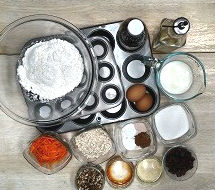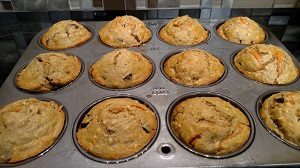 Muffins are easy to make, carry and eat
Muffins are easy to make, carry and eat
Depending on the ingredients, muffins can be a healthy mini-meal or a between-meal snack. When we buy muffins at the store or bakery, they are often a dense cupcake without frosting, high in fat and sugar and low in fiber, protein and nutrition.
Homemade muffins, however, can provide family members with a healthy and tasty food choice. Muffins made the day or night before provide a nutritious and convenient breakfast for those busy mornings. Children will be happy with a yummy, grab-and-go muffin breakfast. They can also be enjoyed with a beverage for a relaxed and easy breakfast or snack on days when you have more time.
Strategies for making healthy muffins
- Size of Pan – Use standard (½ cup) or mini (1/8 cup) pans to control portion size.
- Whole Grains – Substitute up to ½ of the all-purpose flour called for in the recipe with whole grain flour.
- Fruit – stir into the batter one of the following:
- Dried Fruit: ½ cup to 1 cup (raisins, cran-raisins, chopped apricots, dates or figs)
- Fresh Fruit: 1 cup to 1½ cups of chopped fresh fruit (berries, apples, peaches, mango or mashed banana)
- Vegetables – stir into the batter one of the following:
- Grated Fresh Vegetables: ½ cup to 1 cup (carrots or zucchini)
- Cooked, Mashed or Canned Vegetables: ½ cup to 1 cup (sweet potato, green peas or pumpkin)
- Finely chopped Fresh vegetables: Add a total of 1 cup of a mixed variety of vegetables
- Reduce Fat – Use no more than ½ cup oil or other fat per 12 regular size or 40 mini size muffins. If the recipe calls for more fat, substitute apple sauce or mashed cooked vegetables for the rest of the fat. Note: Completely fat free muffins can stick to paper liners making them hard to eat.
- Reduce Sugar – Use no more than 2/3 cup added sugar (brown sugar, honey, maple syrup or agave) per 12 regular size muffins. Spices and flavorings like cinnamon, ginger, nutmeg, cloves, grated orange rind and vanilla add a sweet flavor without adding sugar.
- Protein: Add an extra egg for more protein or substitute ½ cup of the all purpose flour with nut flour. You can also stir in ½ cup nuts, or substitute up to ¼ cup of sugar with 1/4 cup non-fat dry milk to add more protein.
 Get everyone involved in recipe development and baking
Get everyone involved in recipe development and baking
Ask family members for suggestions on the fruits, vegetable or nuts they would like in their muffins. Better yet, get family members involved in making them. As long as the kitchen is dirty and the oven is on, why not bake-up more than one batch, with different combinations of fruits or vegetables? Write down any changes you made to the recipe you used so that you can repeat your family’s favorite recipe. Extra muffins? No problem, they freeze well and thaw quickly!
Colorado is known for its high elevation. Depending upon where you live throughout the world, high elevation modifications may need to be made to your recipe for best quality.
For some tasty recipes that have already been developed with health in mind, check out these issues of the Colorado State University Extension Family Matters Newsletter.
- Protein packed quiche type muffin recipe in the Family Matters Newsletter, September 2016 “The Power of Protein”
- Healthy carrot muffin recipe in the Family Matters Newsletter, March 2018 “March Muffin Makeover”
- Moist banana oat muffin recipe in the Family Matters Newsletter, April 2017 “For the Love of Bananas”


Can’t wait to try some of these options, as several are new to me!
I made the carrot muffin recipe using apples instead of carrots. It was yummy.
Glenda
Thanks for sharing. I will have to try it with apples myself.